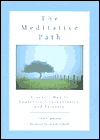
In Japan, there was once an old monk who lived alone in a small meditation hermitage in the mountains. He went about his daily chores with a careful grace that reflected his inner peace and clarity. He had, however, one peculiarity. Every now and then, for no apparent reason, he called out his own name. By this simple action, it is taught, he brought himself back into the present moment, reestablishing awareness whenever he noticed that his mind had drifted into forgetfulness.
Although it is not necessary for us to adopt that monk's method of practice, this story illustrates the obstacle we face when we try to arouse awareness in daily life. Though we may sincerely aspire to be awake in every moment, doing so is difficult because of the power of habit and forgetfulness. Therefore, rather than expecting to achieve continuous awareness immediately, we begin by developing mindfulness around a small number of routine tasks. Then, as we become more skilled at maintaining awareness in the mind, we gradually incorporate more aspects of daily life into the practice of Meditation in Action.
It is important to understand that to develop awareness in daily life we do not need to go around with an empty mind. Rather, we strive to be awake and centered in the present, clearly knowing at each moment what we are doing. For instance, if you are walking down the street to the bus stop, the mind knows that the body is walking. If thoughts, plans, or memories come into the mind, the mind is aware of them. When you come to an intersection, you know it and can decide whether or not it is safe to cross.
Naturally, thoughts, plans, and memories may come up while we are engaged in an activity, but these need not be an obstacle to awareness. The obstacle of forgetfulness arises from our habitual tendency to get lost in a jungle of thoughts, one leading to another without conscious direction or purpose. If it is necessary to plan for the future, then by all means we should do so, and make the best plan possible. But we should plan for the future with awareness and clarity, rather than just by daydreaming.
Through the practice of Meditation in Action, you come to realize that a good portion of thinking is habitual. The restless mind fills with idle chatter to keep it occupied because it does not know how to relax. Unfortunately, all this clutter stifles the mind, keeping it from developing important and meaningful insights. Through awareness, we can thin out the jungle of thoughts, discarding a lot of the trivial and useless chatter so that we can experience greater clarity.
When we are practicing Meditation in Action, we still experience thinking, seeing, hearing, feeling, and other mental and physical activities, but we remain centered on whatever main activity we are involved in at that moment. When trivial thoughts come into the mind, we let them go, because there is something more important and meaningful for the mind to be involved in -- the present experience. If something important comes up that needs to be thought about, and it is a suitable time to be thinking about such things, then we can, of course, think about it. When we do, this new thought becomes the present activity for the light of awareness. Like sunshine, the light of awareness shines on each thing so that it becomes clear.
Practicing Meditation In Action
It's a good idea to begin your practice of Meditation in Action by choosing to shine the light of awareness on four or five routine daily activities. Performing these simple tasks with awareness helps you develop a better appreciation for what the practice is trying to achieve. Here are a few suggestions for how to get started:
Brushing Your Teeth
Most of us brush our teeth twice a day, but we rarely do so with much attention. Usually, while the hand is brushing, the mind is busy thinking or daydreaming, and neither the brushing nor the thinking is done with any real interest. If negative thoughts come into the mind, we may brush in an aggressive manner using excessive force. If the mind is hyperactive and restless, the brushing will tend to be haphazard. Unfortunately, this mechanical way of brushing not only results in more trips to the dentist, but it also perpetuates and reinforces the habits of mental carelessness and heedlessness.
How can you make the act of brushing your teeth a practice of meditation? There is no need for you to brush your teeth in a stylized manner using some special technique. You need only center yourself and bring the mind into the present by thinking, "What am I doing?" Rather than just moving the brush back and forth mechanically, you encourage the mind to be fully involved in the act of brushing.
So begin by intentionally deciding that you want to transform this routine activity of brushing your teeth into a practice of meditation. For these few minutes, relax into the present moment and brush your teeth in a natural way but with awareness.
- Pick up your toothbrush ... is it your toothbrush?
- Apply the toothpaste ... how much toothpaste do you use?
- Begin to brush your teeth ... which teeth do you brush first?
Continue to brush your teeth with this sort of interest, being aware of how much pressure you are applying and what area you are brushing, making sure that you actually brush all the teeth.
Of course, thoughts will come into the mind, but because there is awareness, you will notice the thinking. If what arises in the mind is just trivial chatter, let it go, and come back to brushing your teeth, keeping your mind and body together throughout the activity.
A dentist once told me that to brush the teeth properly, we should brush for about three minutes. If you brush your teeth with awareness, then not only will your teeth be cleaner, but you will have also practiced three minutes of meditation! When you practice Meditation in Action, you do not have to "make time" for meditation; rather, you discover that you have all the time you need because you live more fully in each moment.
Showering
Showering is a most pleasant and relaxing daily activity, but most of the time we do not really experience it. While the body is in the shower, the mind is busily someplace else. But not any longer! Next time you take a shower, make sure that the mind is taking a shower with the body.
Bring your attention into the present moment and notice the pleasant feeling of the water on your body. Allow the warmth of the water to soothe and relax the muscles, relieving all the built up tension. Try to keep the mind with the body as you soap up, enjoying the fragrance of the soap and the smooth feeling of it on your body. When you rinse off, let all the cares of life fall away, just like the soap that is being rinsed away. While drying the body, encourage the mind to be there, experiencing and enjoying the feel of the towel on the skin.
Whatever thoughts, memories, or plans pass through the mind, simply know them and deal with them as seems appropriate. Again, you may find that most of the mental activity is just habitual chatter. Let it go, and continue to enjoy these pleasant moments. After showering in this way, not only will you be physically cleansed and refreshed, but you will also feel mentally refreshed, centered, and clear.
Walking
Many people take up walking for health reasons, but all too often, the result is "mindless bodies" walking for exercise. Why not make better use of this activity? It is also possible to develop awareness during an ordinary daily walk. Going for a pleasant stroll in the park can be an excellent opportunity for developing Meditation in Action.
To make your stroll a meditation, simply walk in your usual way, but encourage the mind to walk with the body. Relax into the present moment, allowing the mind to become quiet and to enjoy the pleasure of rhythmic movement. Your mind and body are together, peacefully walking, enjoying the walk. As a traditional saying puts it, "Tread gently in this place of peace, and peace will be with you."
If you are walking in a park with trees and flowers, notice the beauty of nature by staying fully present to what's around you in each moment. Whatever goes through the mind, just know it as mental "stuff." Is it really worth bothering about? Is it important enough to take you away from what is right here, right now? If there is something really important that you need to think about, then do so with awareness. But if what's running through the mind is just trivial, leave it behind and continue to enjoy the walk.
When the mind and body walk together in this way, not only do we benefit physically, but we realize how wonderful it is to be awake.
Washing Dishes
Most people do not like washing dishes and do so with a lot of negative thoughts and feelings that make the chore a miserable experience. Other people wash dishes in a half-hearted way, mainly daydreaming, which results in many chipped and broken dishes. One meditation teacher told me that he could assess the general quality of meditation among the students by the number of chipped cups in the kitchen!
Since we need to wash dishes, why not transform this mundane task into an opportunity for meditation? Again, center yourself, and bring the mind into the present by being aware of what you are doing now:
- Feel the temperature of the water in the sink ... is it hot enough?
- Add detergent ... how much are you using?
- Wash each dish ... have you scrubbed every surface?
- Rinse each dish ... how clean is it?
Since the mind has also been washing the dishes, the dishes get washed more carefully. When you have finished, clean the sink and enjoy the feeling of having completed a task and done it well. It is extremely gratifying to transform a sink full of messy dishes into a stack of sparkling clean dishes. But it is even more gratifying to know that, by taking this opportunity to practice Meditation in Action, you are bringing greater peace and clarity to everyday life.
Many of the chores you do around the house can be used in a similar way to practice Meditation in Action. Doing so takes no extra time and requires no special conditions. Washing the car, gardening, sweeping, vacuuming, painting, and many other activities can become part of your meditation practice. All you need to do to transform these chores into meditation is to establish and maintain awareness while doing them.
Driving
I once saw a cartoon strip that illustrates the habits of today's drivers perfectly. A man is driving a car along the highway. In each consecutive panel, the man is doing one extra thing in addition to driving. First, the man is just driving; then he is driving and listening to the radio; next he is driving, listening to the radio, and eating a sandwich. Finally, he is driving, listening to the radio, eating a sandwich, and talking on a cellular phone!
Perhaps we're not as dangerously busy as this man when we drive, but how often are we really aware of what we're doing at each moment? Next time you drive your car, try practicing Meditation in Action for a little while. Turn off the radio and relax into driving in a wakeful manner. Driving requires that you remain aware of many things in a continuously flowing way, so you need to stay in the moment. If you are driving with awareness:
- You will know your speed ... are you within the speed limit?
- You will notice the car ahead of you . . . are you too close?
- You will keep an eye on the rearview mirror ... what is behind you?
- If there are traffic lights coming up, you will see them . . . are they red or green?
Many thoughts will pass through the mind, but you'll continually bring your attention back to the present and drive with awareness. Even if the thoughts seem very important, this is not the time to practice awareness of thinking! It is too dangerous. When driving, it is best just to drive.
If more people practiced driving with awareness, the number of car accidents would diminish. So try gradually to broaden the scope of your practice of Meditation in Action to include time spent behind the wheel. You will find that, in addition to being safer, driving will be a much less stressful experience.
Eating
The last exercise I wish to recommend is what I call the "apple meditation."
Most of us like food, talk a lot about food, and sometimes spend a lot of money to eat in expensive restaurants. But how often are we actually present to the full experience of eating? Part of the reason we do not pay much attention to eating is because it often takes place in a social setting with conversation and other activity going on. If you are having dinner with a friend who wants to discuss something important, it certainly would not be appropriate for you to be overly interested in the taste of your food. There is a time and place for everything.
However, when you have an opportunity, try this exercise in mindfully eating. Choose an apple or some other fruit of your liking and sit down comfortably so that you can enjoy eating this apple. Begin by peeling the apple with a knife, going around carefully so that the peel comes off in one long, continuous strip. You will quickly discover that if your mind is too busy or distracted, the peel will not form one single strip. So bring awareness into the activity of peeling.
Having peeled the apple, slice it and eat one slice at a time. Feel the texture of the apple as you chew, savor the flavor, and swallow each mouthful before eating the next slice. No need for a running commentary; simply discard the unnecessary chatter and be fully present to the experience of eating this wonderful apple.
Drop by drop,
The bucket is filled.
Moment by moment,
Awareness is developed.
As explained earlier, our goal is to incorporate as much of our daily activity as possible into our practice of Meditation in Action, so that living and meditation merge into one process -- a meditative life. A great Chinese master described this practice with these words:
How wonderful!
Quite miraculous!
I am fetching water!
And carrying wood!
-- Timothy Freke, Zen Wisdom
We may never achieve such a lofty state of full awareness, but through vigilant effort we can become more centered, awake, and peaceful in the midst of daily activity.
Reprinted with permission of the publisher,
Quest Books. ©2001. www.questbooks.net
Article Source
The Meditative Path: A Gentle Way to Awareness, Concentration, and Serenity
by John Cianciosi. Directly from the heart, this practical, nonreligious book guides the reader of any faith to reduce stress, increase health, and achieve inner peace. It clearly explains the meditative process and offers very simple exercises to balance theory and practice. Each chapter includes Q&A sections based on the average reader's experience and crafted from the author's twenty-four years of teaching, first as a Buddhist monk and now in lay life. Of all primers on meditation, this one excels in showing how to slow down life in the fast lane.
Directly from the heart, this practical, nonreligious book guides the reader of any faith to reduce stress, increase health, and achieve inner peace. It clearly explains the meditative process and offers very simple exercises to balance theory and practice. Each chapter includes Q&A sections based on the average reader's experience and crafted from the author's twenty-four years of teaching, first as a Buddhist monk and now in lay life. Of all primers on meditation, this one excels in showing how to slow down life in the fast lane.
Info/Order this book. Also available as a Kindle edition.
About the Author
John Cianciosi, a student of the late Venerable Ajahn Chah, was ordained a Buddhist monk in 1972 and served as spiritual director of monasteries in Thai-land and Australia. In 1995 he left the monastic life and moved to the Chicago, Illinois area, where he continues to share his insights and wisdom as a lecturer at the College of DuPage. His teachings come directly from the heart, having been nurtured by a life devoted to the study and practice of meditation.
Related Books
at InnerSelf Market and Amazon





























